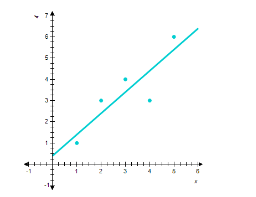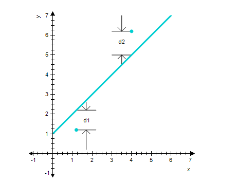Multiple Choice
Determine whether the statement is true or false. If it is true, explain why it is true. If it is false, give an example to show why it is false.
The least-squares line must pass through at least one data point.
A) It is false. Example. Find the least-squares line for the data  Solution. Here, we have n=5 and
Solution. Here, we have n=5 and  The least-squares line for the data is given by linear equation y= f(x) = mx+b where the constants m and b satisfy the normal equations
The least-squares line for the data is given by linear equation y= f(x) = mx+b where the constants m and b satisfy the normal equations 

 Then, we obtain the normal equations
Then, we obtain the normal equations  Solving them, we found m=1, b=0.4 Therefore, the required least-squares line is y= x+0.4 The scatter diagram and the least-squares line are shown in the figure. We can see that the line does not pass through any data point.
Solving them, we found m=1, b=0.4 Therefore, the required least-squares line is y= x+0.4 The scatter diagram and the least-squares line are shown in the figure. We can see that the line does not pass through any data point.
B) It is true, Suppose that we are given two data points  If we try to fit a straight line to these data points, the line will miss the first and the second data points by the amounts d1, d2, respectively.
If we try to fit a straight line to these data points, the line will miss the first and the second data points by the amounts d1, d2, respectively. 
The principle of least squares states that the straight line L that fits the data points best is the one chosen by requiring that the sum of the squares  be made as small as possible. But it is possible only in case when least-squares line passes through at least one data point.
be made as small as possible. But it is possible only in case when least-squares line passes through at least one data point.
Correct Answer:

Verified
Correct Answer:
Verified
Q32: A building in the shape of a
Q33: Find the equation of the least-squares line
Q34: Find the critical point(s) of the function.
Q35: Let <img src="https://d2lvgg3v3hfg70.cloudfront.net/TB8255/.jpg" alt="Let .
Q36: The flow of blood through an arteriole
Q38: Let <img src="https://d2lvgg3v3hfg70.cloudfront.net/TB8255/.jpg" alt="Let .
Q39: Use a double integral to find the
Q40: Maximize the function<br> <img src="https://d2lvgg3v3hfg70.cloudfront.net/TB8255/.jpg" alt="Maximize the
Q41: Find the first partial derivatives of the
Q42: Find the approximate change in z when